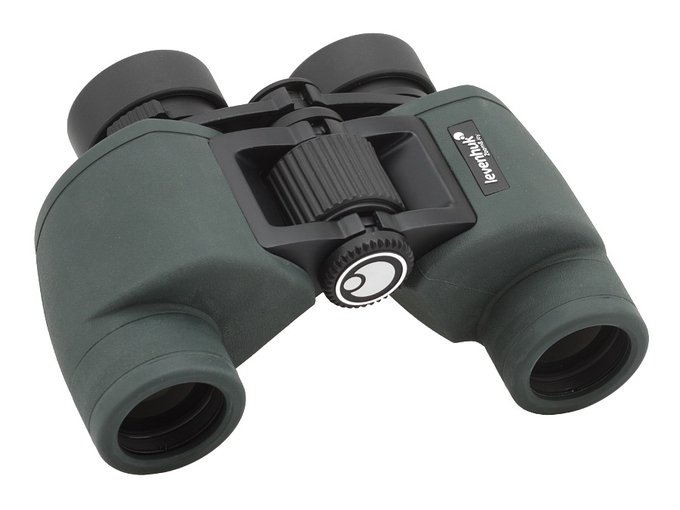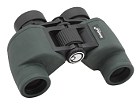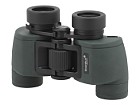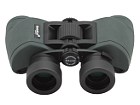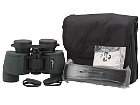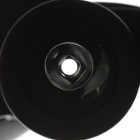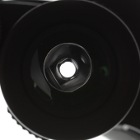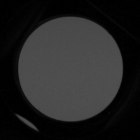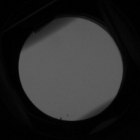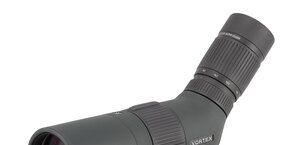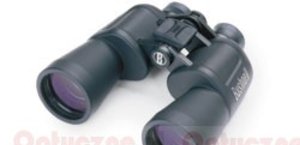Levenhuk Sherman Pro 6.5x32
Buyers get caps for eyepieces and objective lenses, a case, a strap, a cleaning cloth, an instruction manual and a warranty card. The binoculars come with the lifetime warranty period.
| Magnification | Lens diameter | Angular field of view | Prisms | Eye relief | Weight | Price |
|---|---|---|---|---|---|---|
| 6.5 | 32 | 175/1000(10o) | BaK-4/Porro | 21 mm | 730 g | 645 PLN |
Summary
Pros:
- compact and solid body,
- quite wide field of view,
- good sharpness on the edge of the field,
- proper transmission,
- good colour rendering,
- sensible correction of chromatic aberration,
- very low distortion,
- slight astigmatism,
- not very bothersome brightness loss on the edge of the field,
- lifetime warranty.
Cons:
- rubber armour of objective lenses can be peeled off
- a lot of reflections near exit pupils,
- field of view a bit narrower than declared in the specifications,
- noticeable vignetting in the right exit pupil.
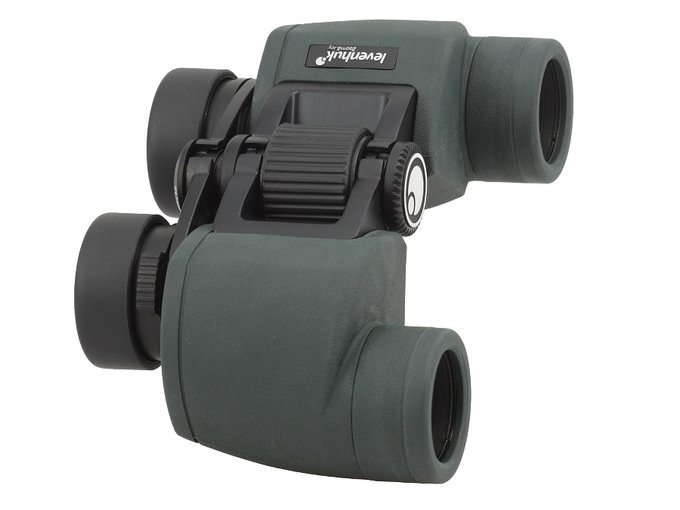 |
Binoculars with the magnification of 6-7 times have been slowly disappearing from the market. 7x50 parameters, which used to be very popular, now are very hard to find. Even several years ago every self-respecting producer had to include the 7x42 instrument in their line-up; nowadays they usually limit their offer to two devices, the 8x32 and the 10x42. A shift toward bigger magnification values is also noticeable when it comes to binoculars with objective lenses as big as 30-32 mm. In the past you could easily find a 6x30 or a 8x30 device; nowadays more often than not these are rather 8x32 and 10x32 models. What’s more, many producers used to offer 7x35 and 6x24 binoculars with a wide field of view, among them such cult instruments as the
Leica Ampivid or Trinovid.
Currently the market is inundated with models featuring 8-10 times magnification and smaller values are very hard to find. If a producer decides to launch a 6x30 or a 6x32 device such a pair of binoculars has the same or almost the same field of view like the 8x model.
The sad truth is that the lack of binoculars with smaller magnification hurts two age groups at the same time: the youngest and the oldest users. When my son was 5 he got his first 8x pair of binoculars. Soon enough it became obvious that the instrument is too big for him - it wobbled in his hands and its field of view was too narrow to allow him to locate objects of observation. Already at that time I found out that a perfect instrument for small children should weigh less than 500 grams and have magnification around 6x, with a field of view as wide as 10-12 degrees and 24-32 mm objective lenses.
Similar things can be said about the elderly people. While visiting different forums I’ve read time and again letters of senior bird and nature watchers who wanted to exchange their 10x42 instruments for 7x models because they found it more and more difficult to keep the set of binoculars with a higher magnification stable in their hands.
My son has already grown taller than me and he handles binoculars with higher magnification without any problems but the topic hardly disappeared from the household. My daughter, a delicate 8-year-old girl, has also become a huge binoculars fan and once again she prefers devices with lower magnification and a wide field of view.
That’s why I have been following the launches of 24-32 mm binoculars with 6-7x magnification attentively. The Vortex Raptor 6.5x32 let me down – its field of view is too narrow and its eyepieces very sensitive when it comes to looking at a light source off the optical axis. It is completely unsuitable for children and might prove quite bothersome for an adult user too. When the Levenhuk equipment hit the shelves in Poland I immediately knew I would like to test it. I was especially interested in the Sherman Pro 6.5x32 which, according to specifications, was supposed to have a field of view of 10 degrees. Such parameters are truly unique; with a price amounting to about 150 Euro, it was enough it fared decently well in the tests and it would be completely recommendable.
Levenhuk went over the top with the field of view value in their specifications because the real field amounts to 9.1 degrees. It doesn’t sound so impressive like 10 degrees but still it is able to provide the eyepieces’ field of a bit more than 60 degrees, meaning a very comfortable observation, without an impression that you are looking through a keyhole.
The tested binoculars repeated the slip-up of the 8x32 model with the lack of glue under the rubber armour of the eyepieces – as a result its armour is completely removable as well.
Another slip-up, quite surprising from my point of view, was the appearance of the right pupil. You could notice ‘little diamonds’ there, much more characteristic for Bk7 than BaK-4 prisms, allegedly used by Levenhuk. What’s even more interesting, I had an opportunity to handle some 6.5x32 models during our Binoculars Festival in Łochów and I didn’t notice such an effect. Graying areas near the edge of the exit pupil were distinct only when you looked at it at an angle, it disappeared when you looked straight on. At such a price point there might be significant quality differences between particular specimens so if you decide to buy the Sherman Pro 6.5x32 pay the exit pupils closer attention and try to chose a model with them looking properly well. That slip-up cost the binoculars 4 points; that’s why its final result is not identical with the result of the 8x32 model, so praised by us.
A different eyepiece construction caused changes in the transmission graph as well.
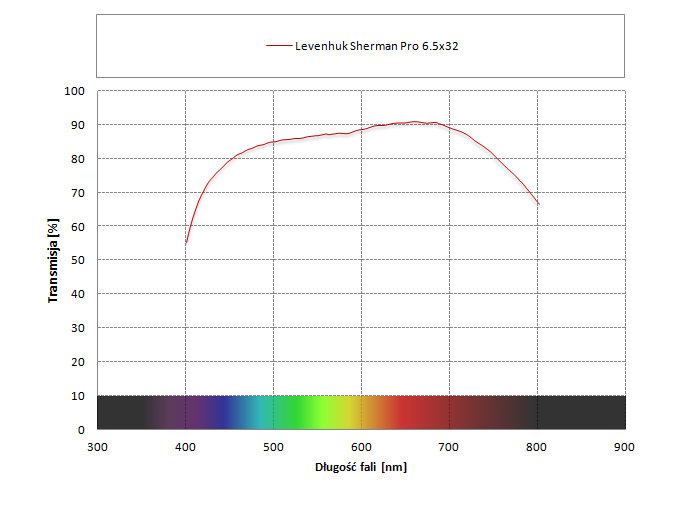 |
This time a depression in the centre of the visible spectrum is barely noticeable and, as a result, the overall transmission in that part of the spectrum is higher than the respective transmission of the 8x32 model. Overall the inclination of the graph is more pronounced so the colouring of images seems to be slightly worse.
So far we’ve described only disadvantages but you mustn’t forget about advantages because there are more of them. A quite large field of view is sharp, with low astigmatism and imperceptible distortion; also the chromatic aberration won’t bother you in its centre. The pair of binoculars is comfortable to handle and it doesn’t look shoddy.
To sum up if you choose a model with nice exit pupils once again you can get a device similar to the well-known and quite praised Nikon Action EX. For anybody with a budget of 100-200 Euro the Sherman Pro models are completely recommendable.




